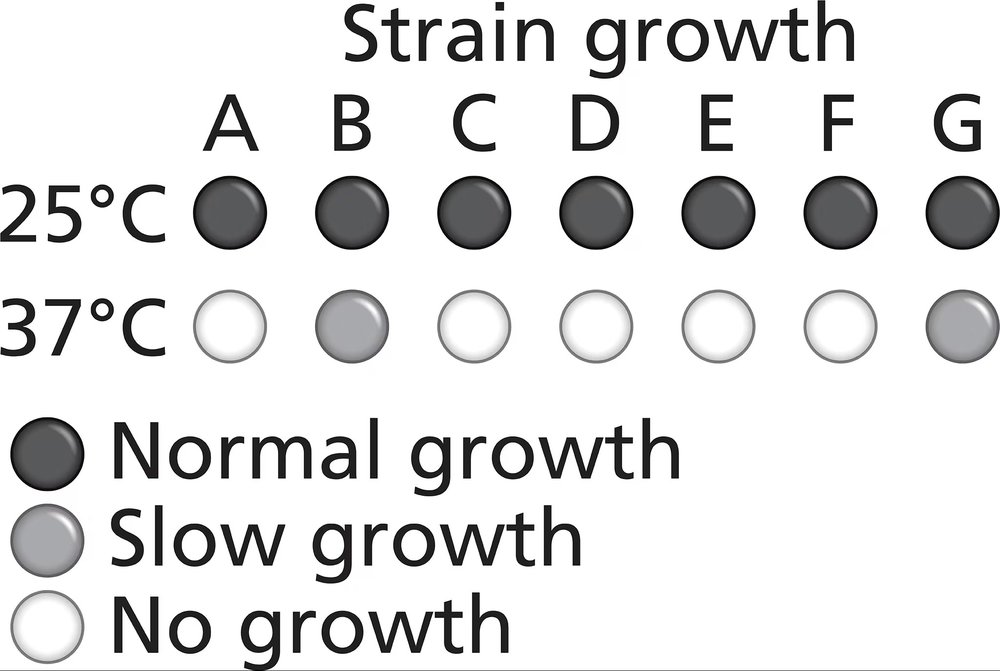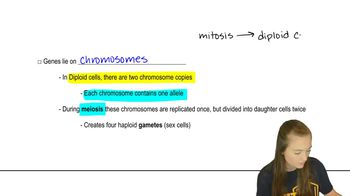Table of contents
- 1. Introduction to Genetics51m
- 2. Mendel's Laws of Inheritance3h 37m
- 3. Extensions to Mendelian Inheritance2h 41m
- 4. Genetic Mapping and Linkage2h 28m
- 5. Genetics of Bacteria and Viruses1h 21m
- 6. Chromosomal Variation1h 48m
- 7. DNA and Chromosome Structure56m
- 8. DNA Replication1h 10m
- 9. Mitosis and Meiosis1h 34m
- 10. Transcription1h 0m
- 11. Translation58m
- 12. Gene Regulation in Prokaryotes1h 19m
- 13. Gene Regulation in Eukaryotes44m
- 14. Genetic Control of Development44m
- 15. Genomes and Genomics1h 50m
- 16. Transposable Elements47m
- 17. Mutation, Repair, and Recombination1h 6m
- 18. Molecular Genetic Tools19m
- 19. Cancer Genetics29m
- 20. Quantitative Genetics1h 26m
- 21. Population Genetics50m
- 22. Evolutionary Genetics29m
17. Mutation, Repair, and Recombination
Types of Mutations
Problem 28b
Textbook Question
Yeast are single-celled eukaryotic organisms that grow in culture as either haploids or diploids. Diploid yeast are generated when two haploid strains fuse together. Seven haploid mutant strains of yeast exhibit similar normal growth habit at 25°C, but at 37°C, they show different growth capabilities. The table below displays the growth pattern.

Researchers induce fusion in pairs of haploid yeast strains (all possible combinations), and the resulting diploids are tested for their ability to grow at 37°C. The results of the growth experiment are shown below. How many different genes are mutated among these seven yeast strains? Identify the strains that represent each gene mutation.
 Verified step by step guidance
Verified step by step guidance1
Step 1: Understand the problem. The question asks us to determine how many different genes are mutated among the seven yeast strains and to identify which strains correspond to each gene mutation. This involves analyzing the complementation test results from the diploid yeast growth experiment.
Step 2: Recall the concept of complementation. Complementation occurs when two haploid strains with mutations in different genes are fused, and the resulting diploid can grow normally. If the diploid cannot grow, it indicates that the mutations are in the same gene.
Step 3: Analyze the data. Look at the growth patterns of the diploid strains at 37°C. For each pair of haploid strains, determine whether the diploid grows or not. If the diploid grows, the mutations complement each other, meaning the mutations are in different genes. If the diploid does not grow, the mutations are in the same gene.
Step 4: Group the haploid strains based on complementation results. Strains that do not complement each other (i.e., their diploids do not grow) belong to the same complementation group, which corresponds to a single gene mutation. Count the number of distinct complementation groups to determine the number of genes mutated.
Step 5: Assign each haploid strain to its respective complementation group. Based on the results of the complementation test, identify which strains belong to each group, and label them according to the gene they represent. This will provide the final classification of strains by gene mutation.
 Verified video answer for a similar problem:
Verified video answer for a similar problem:This video solution was recommended by our tutors as helpful for the problem above
Video duration:
2mPlay a video:
Was this helpful?
Key Concepts
Here are the essential concepts you must grasp in order to answer the question correctly.
Haploidy and Diploidy
Haploidy refers to cells that contain a single set of chromosomes, while diploidy indicates cells with two sets. In yeast, haploid strains can mate to form diploid cells, which can then undergo genetic analysis. Understanding the difference between these two states is crucial for analyzing genetic mutations and their effects on growth under varying conditions.
Recommended video:
Guided course

Diploid Genetics
Gene Mutation and Phenotypic Expression
Gene mutations are alterations in the DNA sequence that can affect an organism's traits or phenotypes. In the context of the yeast strains, different mutations may lead to varied growth capabilities at elevated temperatures. Identifying which strains exhibit distinct growth patterns helps in determining the number of unique gene mutations present among the haploid strains.
Recommended video:
Guided course

Mutations and Phenotypes
Genetic Complementation Testing
Genetic complementation testing is a method used to determine whether two mutations that produce a similar phenotype are in the same gene or in different genes. By fusing haploid strains and observing the growth of the resulting diploids, researchers can infer the number of distinct mutations and identify which strains represent each gene mutation based on their growth capabilities at 37°C.
Recommended video:
Guided course

Complementation
Related Videos
Related Practice
Textbook Question
Imagine yourself as one of the team of geneticists who launches a study of the genetic effects of high-energy radiation on the surviving Japanese population immediately following the atom bomb attacks at Hiroshima and Nagasaki in 1945. Demonstrate your insights into both chromosomal and gene mutation by outlining a short-term and long-term study that addresses these radiation effects. Be sure to include strategies for considering the effects on both somatic and germ-line tissues.
700
views


